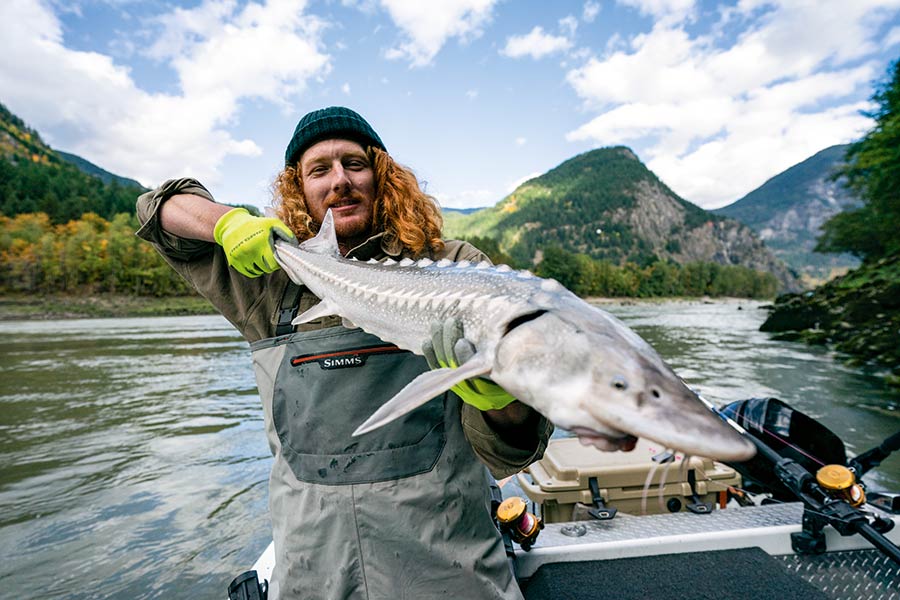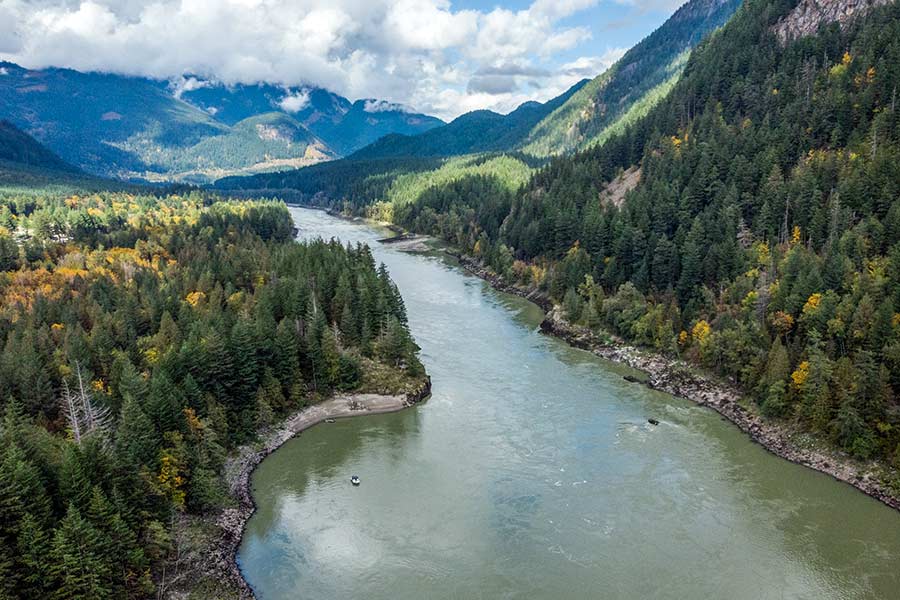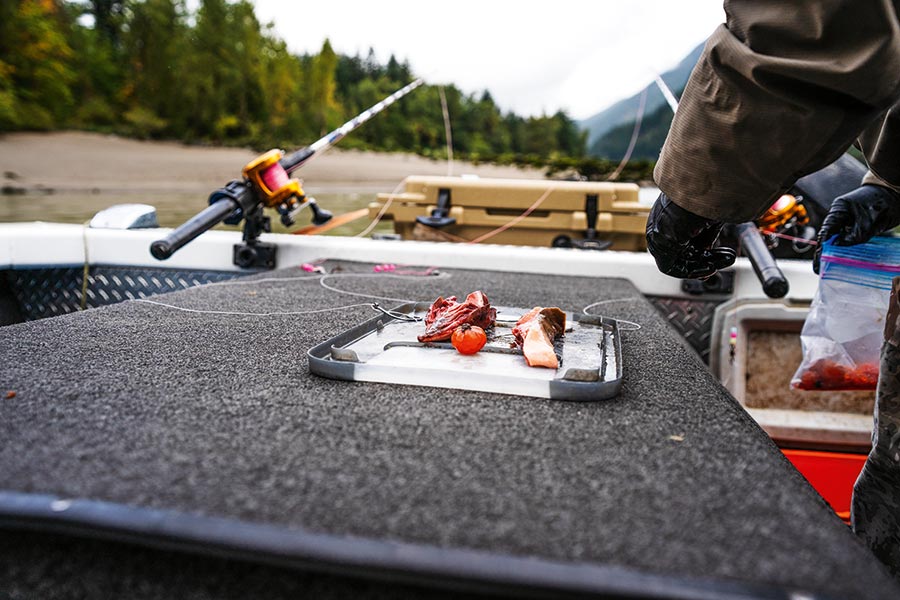Catching White Sturgeon in British Columbia
Kiwi angler Jason Harmon has recently returned from his OE, during which he spent time in British Columbia targeting a bucket list species – white sturgeon. As Jason’s words and Kristian Gillies’ images suggest, catching a prehistoric river monster is full of challenges and surprises.
Wait for it,” the guide mutters as my rod tip dips repeatedly and the taut 80lb braid pulsates with the unmistakable rhythm that says there’s something alive on the end of it.
“Wait for it.” I can hear the ratchet sound on my reel start to sing as the line whips off it, quicker and quicker with each passing second.
“Wait for it.” This time he almost yells it at me, like you would to a dog caught eyeing-up your Christmas ham on the bench. I feel like I’m jacked-up on a dozen cups of coffee – the anticipation is unreal. For sure, this fish is going to get away.
“Hit ‘em, now!”
Before he even finishes his words, I launch the rod up towards my left shoulder, visualising the 7/0 hook burying itself in the fish’s jaw. All I feel is weight: massive, incomprehensible, ridiculous weight. The rod is bent savagely in a stiff arc, the line tight like a guitar string.
Then there is a series of violent, ominous headshakes and several steaming runs, before the line starts tracking rapidly towards the surface. “He’s gonna jump!” yells the guide.
Everyone on board the boat looks up in unison as the grey surface of the river erupts in an explosion of white-water, out of the middle of which ascends the massive head, then body, of a writhing prehistoric river monster: the white sturgeon of British Columbia.
It’s no coincidence that we were located in “Jurassic Park”, a stunning section of the Fraser River valley in British Columbia, Canada, renowned for its primordial landscapes. It’s exactly the kind of place you’d expect to find monsters.

Locked and loaded. The writer tangles with his first Fraser River sturgeon.
Earlier that morning, we’d been picked up from the hotel by our guide, Landon Gill of Great River Fishing Adventures. After a short drive towards the township of Hope, we’d arrived at the boat launch.
“There was a pack of timber wolves spotted here just two days ago,” Landon commented nonchalantly, as he waved his arm in the direction of the forest. “They just came out of the forest and stood there, ‘bout five of ‘em, staring at my friend. He got a sweet video.”
We launched his 24-foot jet boat into the large, murky Fraser River and motored eastward up the misty valley. As far as the eye could see, the river was lined with dense coniferous forests: the epitome of Canadian wilderness. Along the way, Landon had explained the unique Fraser River fishery to us.
“The Fraser River is the longest river in British Columbia and flows for 1,370 kilometres,” he said. (New Zealand’s longest river, the Waikato, is a modest 425 kms in comparison.) “The ecosystem here supports one of the largest salmon populations in the world,” Landon continued, “including all five species of Pacific salmon: chinook (quinnat), coho, sockeye, chum and pink. It also hosts two species of trout: the ocean-going rainbow (known as steelhead) and the coastal cutthroat. There are also two species of char: bull and dolly varden.

Guide Landon Gill with a ‘mini-minor’ version of a white sturgeon. Scientists have recorded fish at 5.97m (19.6ft) – the length of an ‘average trailer boat’.
“But the white sturgeon is what really sets this river apart from the rest. Sturgeon have been caught and released here that were over 12 feet (3.65m) in length and 1000lbs (450kg) in weight. Scientists think a fish that big is probably close to 150 years old. Still, I know there are older, bigger fish out there. Every year fish are hooked and we never see ‘em, ‘cause you just can’t get ‘em to the boat – no matter how tough you think you are. There’s a fish-counting sonar set up in the river here that has recorded one giant sturgeon at 16.6 feet (5.05m) and another at 19.6 feet (5.97m).”
“I wanna catch one of those monsters,” I blurted out. Sturgeon had been high on my bucket list for several years, ever since I first saw Englishman Jeremy Wade catch one on his TV show River Monsters.
Landon grinned at me. “Well, today is your chance!”
He slowed the boat and pulled into a large eddy on the side of the river. “We’re here,” he said. “Welcome to Big Eddy, where the magic happens.”

Big Eddy, as the name suggests, is a large backwater to the side of the Fraser River’s main flow, and is prime sturgeon territory.
As if on cue, sturgeon started splashing on the surface beside the boat. Before I could even ask – “They’re coming up for air,” Landon stated matter-of-factly, as he lowered the anchor at the front of the boat. “They don’t have swim bladders like other fish, so they need to gulp air into their stomachs to act as floatation. There’s some big ones here.”
I was amazed. I hadn’t expected to be able to see the fish in such murky water. They looked like sharks: each splashy rise accompanied by flashes of girthy, white bodies, and large tail fins slicing through the surface film – like something out of Jaws.
Once the boat was anchored, Landon started to rig up three separate rods.
“Sturgeon like salmon,” Landon commented, as he slid his hand into a pair of rubber gloves to handle the semi-frozen bait. I could smell it before he even took it out of the bag. “Rotten salmon, especially,” he chuckled.
To the first rod he hooked on the oozing head of a pink salmon; to the second, a chunk of pink salmon flesh (skin on); and to the third, a homemade stocking-bag filled with pink salmon roe. The rods themselves were custom made for sturgeon fishing: thick, stout poles that would easily tame even the biggest kingfish.

The bait smorgasbord – rotten salmon head, rotten fillet of salmon with skin on and a fine mesh bag filled with salmon roe. The smellier the bait the better as sturgeon regularly feed on dead salmon carcasses they find on the bottom.
White sturgeon are primarily scavengers, eating decaying salmon carcasses off the bottom of the river. They have a row of barbels under their snout that help them locate food in the dark waters. Their toothless mouths act like vacuum cleaners, articulating and extending in a way similar to that of john dory. Though, the bigger specimens can become predators in their own right, chasing and hoovering up whole fish and crustaceans while they’re still alive.
Within minutes of putting the lines out, we had started getting bites. “There’s probably about fifty sturgeon in this one eddy right now,” Landon said.
Despite good numbers in some areas of the Fraser, the white sturgeon is actually a species at risk in Canada. From 1880 to 1994, they were overfished and have never regained their historical abundance. Sturgeon flesh was widely consumed, but it was their delicate eggs, known as caviar, that were the real driving force behind the brutal harvest. Nowadays, the recreational fishery is catch-and-release only, with conservation license fees going towards research and habitat restoration. Many of the fish caught are also measured, photographed, tagged and tracked – a process that’s helping scientists to better understand the mysterious life cycle of the sturgeon.
Fishing for sturgeon requires a lot of discipline. Much like snapper fishing with big baits, you need to wait for the fish to actually swallow the bait before setting the hook. Those moments leading up to the eat can be agonizing, and several times I struck too early. But eventually, with Landon’s steely guidance, I managed to hold my cool until the right moment.

The terminal tackle needs to be sturdy as these fish can grow to comfortably over a tonne.
And that’s how I found myself clinging to a rod with a sky-lunging sturgeon on the end of it. After the jump, I fought the fish for ten more arm-burning minutes, slowly inching it closer to the boat after each blistering run. When I eventually pulled it alongside, Landon explained that sturgeon less than five feet in length can be brought aboard using a specially designed wooden-framed sling. So, we hauled it up onto the sling and got a proper look at it.
While Landon took the measurements and photos, I stared into its milky-blue eyes and contemplated the fact that these incredible creatures have remained relatively unchanged for millennia, as though evolution had already completed its job long ago. Along the length of its body are bizarre prehistoric bony plates, called scutes, arranged in five distinct rows: one row along the back, two along each side, and two along the belly. These scutes act like protective armour and are sharp to the touch.
Though sturgeon can purportedly survive out of water for up to two days, we opted to get it back in the water quickly. Landon instructed me how to pick up the fish (no easy feat, considering its massive size) and send it headfirst over the side, back into the depths from whence it came.
Fishing for sturgeon should be high on every Kiwi angler’s bucket list and is just one of several unique fisheries available in British Columbia. Reach out to Travel&Co to arrange the trip of a lifetime: https://travelandco.nz/

January 2022 - Jason Harmon
New Zealand Fishing News Magazine.
Copyright: NZ Fishing Media Ltd.
Re-publishing elsewhere is prohibited
Latest Articles

Livebaiting for Kingfish
April 2024Jordan Hensen shares his tips for targeting kingfish using livebaits... Read More >



Going Deeper with Softbaits
April 2024Many people are surprised to learn Mark Kitteridge is happy to use softbaits in 40-50 metres. Indeed, he'll even fish them in depths over 70 metres... Read More >

Jeep Grand Cherokee Hits Kiwi Shores
April 2024Jeep’s new Grand Cherokee has hit Kiwi shores, promising the ideal combination of comfort, space, performance, and towing capability.... Read More >



